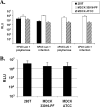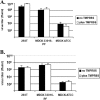Human RNA polymerase I-driven reverse genetics for influenza a virus in canine cells
- PMID: 20071567
- PMCID: PMC2838141
- DOI: 10.1128/JVI.01925-09
Human RNA polymerase I-driven reverse genetics for influenza a virus in canine cells
Abstract
We have established a human RNA polymerase I (pol I)-driven influenza virus reverse genetics (RG) system in the Madin-Darby canine kidney 33016-PF cell line, which is approved for influenza vaccine manufacture. RNA pol I polymerases are generally active only in cells of species closely related to the species of origin of the polymerases. Nevertheless, we show that a nonendogenous RNA pol I promoter drives efficient rescue of influenza A viruses in a canine cell line. Application of this system allows efficient generation of virus strains and presents an alternative approach for influenza vaccine production.
Figures




Similar articles
-
Establishment of canine RNA polymerase I-driven reverse genetics for influenza A virus: its application for H5N1 vaccine production.J Virol. 2008 Feb;82(3):1605-9. doi: 10.1128/JVI.01876-07. Epub 2007 Nov 28. J Virol. 2008. PMID: 18045936 Free PMC article.
-
Cloning of the canine RNA polymerase I promoter and establishment of reverse genetics for influenza A and B in MDCK cells.Virol J. 2007 Oct 23;4:102. doi: 10.1186/1743-422X-4-102. Virol J. 2007. PMID: 17956624 Free PMC article.
-
Establishment of Vero cell RNA polymerase I-driven reverse genetics for Influenza A virus and its application for pandemic (H1N1) 2009 influenza virus vaccine production.J Gen Virol. 2013 Jun;94(Pt 6):1230-1235. doi: 10.1099/vir.0.051284-0. Epub 2013 Mar 13. J Gen Virol. 2013. PMID: 23486669
-
Plasmid-only rescue of influenza A virus vaccine candidates.Philos Trans R Soc Lond B Biol Sci. 2001 Dec 29;356(1416):1965-73. doi: 10.1098/rstb.2001.0979. Philos Trans R Soc Lond B Biol Sci. 2001. PMID: 11779399 Free PMC article. Review.
-
Continuous cell lines as a production system for influenza vaccines.Expert Rev Vaccines. 2009 Dec;8(12):1681-92. doi: 10.1586/erv.09.128. Expert Rev Vaccines. 2009. PMID: 19943763 Review.
Cited by
-
Partial and full PCR-based reverse genetics strategy for influenza viruses.PLoS One. 2012;7(9):e46378. doi: 10.1371/journal.pone.0046378. Epub 2012 Sep 28. PLoS One. 2012. PMID: 23029501 Free PMC article.
-
Research Note: Establishment of vector system harboring duck RNA polymerase I promoter for avian influenza virus.Poult Sci. 2025 Jan;104(1):104570. doi: 10.1016/j.psj.2024.104570. Epub 2024 Nov 22. Poult Sci. 2025. PMID: 39631283 Free PMC article.
-
Many ways to make an influenza virus--review of influenza virus reverse genetics methods.Influenza Other Respir Viruses. 2013 May;7(3):249-56. doi: 10.1111/j.1750-2659.2012.00392.x. Epub 2012 Jun 19. Influenza Other Respir Viruses. 2013. PMID: 22712782 Free PMC article. Review.
-
Reverse Genetics for Peste des Petits Ruminants Virus: Current Status and Lessons to Learn from Other Non-segmented Negative-Sense RNA Viruses.Virol Sin. 2018 Dec;33(6):472-483. doi: 10.1007/s12250-018-0066-6. Epub 2018 Nov 19. Virol Sin. 2018. PMID: 30456658 Free PMC article. Review.
-
Mutations at positions 186 and 194 in the HA gene of the 2009 H1N1 pandemic influenza virus improve replication in cell culture and eggs.Virol J. 2010 Jul 14;7:157. doi: 10.1186/1743-422X-7-157. Virol J. 2010. PMID: 20630098 Free PMC article.
References
-
- Bell, S. P., C. S. Ikaard, R. H. Reeder, and R. Jian. 1989. Molecular mechanisms governing species-specific transcription of ribosomal RNA. Cell 59:489-497. - PubMed
-
- Bell, S. P., H. M. Jantzen, and R. Tjian. 1990. Assembly of alternative multiprotein complexes directs rRNA promoter selectivity. Genes Dev. 4:943-954. - PubMed
-
- Cooper, J. K., G. Sykes, S. King, K. Cottrill, N. V. Ivanova, R. Hanner, and P. Ikonomi. 2007. Species identification in cell culture: a two-pronged molecular approach. In Vitro Cell. Dev. Biol. Anim. 43:344-351. - PubMed
Publication types
MeSH terms
Substances
LinkOut - more resources
Full Text Sources
Other Literature Sources
Research Materials

